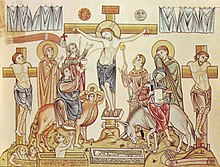Temple curtain

The curtain was a central piece of equipment in the Jerusalem temple . There were two curtains. The outer to the forecourt served to delimit the outer (profane) and the inner (sacred), the inner - more important - the demarcation between the temple area with candlesticks , showbread table and incense altar and the holy of holies with the ark and the two cherubs. According to rabbinical tradition, 82 virgins are said to have made two curtains each year, but it is more likely that the sacred textile was imported from Babylonia.
The cultic significance of the temple curtain, which covered the holy of holies, was that the high priest had to step through it once a year ( Lev 16.2.12-15 EU ) to make an offering and to sprinkle the curtain with blood. A series of magical images associated with the object. According to rabbinical legend, blood came out of him when Titus cut him up with the sword.
The New Testament uses the Greek term catapetasma ( καταπετασμα - that which extends downwards) for the curtain . The synoptic gospels depict the tearing of this inner temple curtain in the immediate temporal connection with the crucifixion of Christ .
| Mt 27 50-51a | Mk 15 37-38 | Lk 23 45b-46 |
|---|---|---|
| ό δέ Ιησούς πάλιν κράξας φωνή μεγάλη άφήκεν τό πνεύμα | ο δε ιησους αφεις φωνην μεγαλην εξεπνευσεν | εσχισθη δε το καταπετασμα του ναου μεσον |
| and Jesus cried out again in a loud voice and gave up the Spirit. | But Jesus gave a loud cry and passed away. | and the curtain of the temple was torn in half. |
| 51a και ιδου το καταπετασμα του ναου εσχισθη απ ανωθεν εως κατω εις δυο | 38 και το καταπετασμα του ναου εσχισθη εις δυο απ ανωθεν εως κατω | 46 και φωνησας φωνη μεγαλη ο ιησους ειπεν πατερ εις χειρας σου παρατιθεμαι το πνευμα μεου τουτο νωνωνωω |
| And behold, the curtain of the temple was torn in two pieces from top to bottom | And the curtain of the temple was torn in two, from top to bottom. | And Jesus called out in a loud voice and said, Father, I deliver my spirit into your hands! And when he said this, he passed away. |
They associate this with the idea that the death of Jesus opens access to the holy of holies.
This notion is taken up in the Letter to the Hebrews (6,19; 9,3; 10,20), where Christ as true high priest and forerunner ( prodromos ) of the community paves the way to the holy of holies.
According to a legend contained in the Proto-Gospel of James from the 2nd century AD, the Virgin Mary was busy making the temple curtain when the angel of the Annunciation appeared to her.
The historian Josephus reports that the curtain of the temple, on which the cosmos was depicted, was shown among the booty in Rome on the triumphal procession of the Flavians after the destruction of Jerusalem. After the triumphal procession the curtain of the temple was deposited in the palace of Vespasian (Jos., Bell VII 162).
In Johann Sebastian Bach's St. Matthew Passion , the scene of the tearing of the curtain is impressively illustrated musically in the recitative And lo and behold, the curtain in the temple was torn .
Individual evidence
- ↑ Joachim Jeremias, Jerusalem at the time of Jesus, 1963, p. 27
- ^ Jeremias, p. 38.
- ↑ Kittel, ThWBNT III, p 631
- ↑ Georg Röwekamp: Jakobus (d. J.) - Literature. In: Siegmar Döpp , Wilhelm Geerlings (Hrsg.): Lexicon of ancient Christian literature. Herder, Freiburg im Breisgau 1998, ISBN 3-451-23786-5 , p. 325.
- ↑ Martin Ebner: The Gospel of Mark . In: Martin Ebner, Stefan Schreiber (eds.): Introduction to the New Testament . 2nd Edition. Kohlhammer, Stuttgart 2013, ISBN 978-3-17-023093-4 , pp. 173 .
literature
- Carl Schneider: Art .: καταπέτασμα, Theological Dictionary for the New Testament (ThWbNT), ed. by G. Kittel, Stuttgart 1957, p. 630 ff.